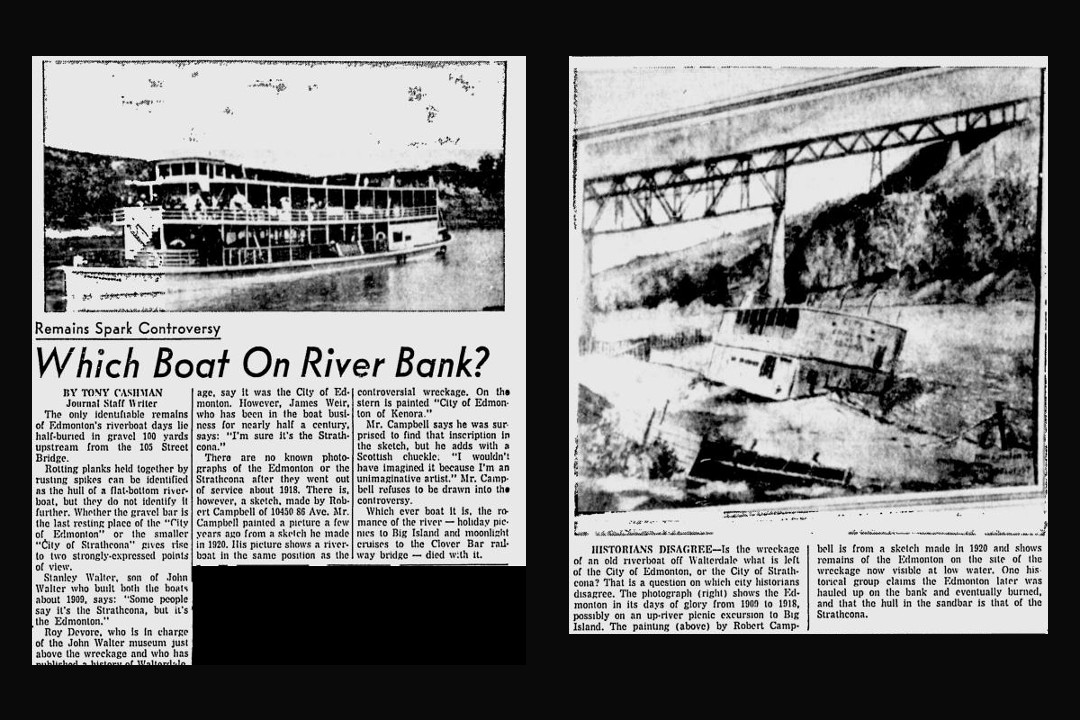On this day in 1960, history buffs debated the identity of a wreckage that dated back to Edmonton's riverboat days.
Were the remains of a riverboat half buried in gravel near the Walterdale Bridge those of the City of Edmonton or the Strathcona? Both were well-known boats in Edmonton's early years but, by 1960, all that was left was "rotting planks held together by rusty spikes," according to the Edmonton Journal.
Whether the wreckage was the Edmonton or the Strathcona, the vessel found a fitting resting place in the river near the Walterdale Bridge, given the span was named for the man who built both boats.
Riverboats changed the way people travelled to and through the Prairies. The first such boat to reach Fort Edmonton was the Hudson's Bay Company's Northcote, in 1875. While Indigenous people had long used canoes to travel the North Saskatchewan River, and later European fur traders used canoes as well, the introduction of steam-powered riverboats offered unprecedented speed. The Northcote made the journey from Lake Winnipeg to Edmonton in about 14 days, many weeks faster than the trip would take over land.
Sandbars, low water levels, and the strong current all made the river journey difficult. (The word Saskatchewan is based on the Cree word kisiskâciwan, which means "fast-flowing.") But within the next decade, the Hudson's Bay Company had a small fleet of riverboats that connected Fort Edmonton to Winnipeg — the Lily, the Northwest, the Manitoba, and the Marquis. While these boats transported passengers, transporting heavy cargo cheaply and quickly was the central business.
It was around the same time that John Walter started a business building boats. Walter had moved to Fort Edmonton in 1870 to take a five-year contract to build smaller York boats for the Hudson's Bay Company. When his term was up, he settled on a parcel of land on the south bank of the North Saskatchewan. There, he created an independent boat-building company — the start of what would grow into a small industrial empire.
In the 1900s, Walter's workshop produced two steam-powered riverboats: the City of Edmonton, a sternwheeler, and the Strathcona, a sidewheeler. On weekdays, both riverboats hauled cargo for Walter's lumberyard and other businesses; on the weekends and holidays, they carried passengers. The City of Edmonton could hold 400 people at a time and included live entertainment and a dance floor.
Walter was a savvy businessman and offered passengers scenic cruises to Big Island on his boats; he had purchased the land for timber but had plans to turn it into a summer resort. The cruises became a popular weekend activity for Edmontonians wishing to escape the city.
By the 1910s, riverboats were falling out of favour. The railroad had reached Edmonton and became the favoured method for transporting passengers and cargo. Then 1915 saw a devastating flood in the river valley that wiped out Walter's businesses. Soon after, both steamships stopped running. At least one of them ended up buried in gravel near Walterdale Bridge.
Today, one riverboat still churns along the North Saskatchewan. The Edmonton Queen was launched in 1995. That boat has faced rough waters since the beginning. Most recently, the boat spent two years being repaired after being damaged by a large wave. This fall saw The Common celebrate its 14th anniversary with a party aboard the Edmonton Queen.
This clipping was found on Vintage Edmonton, a daily look at Edmonton's history from armchair archivist @revRecluse of @VintageEdmonton.

